Updated 20 March 2023 at 07:50 IST
NASA's 30-year satellite record helps scientists predict rising sea levels trajectory
Satellite data has helped scientists understand the rate at which sea levels are rising, a determinant that can help experts prepare for future events.
- Science News
- 2 min read

A detailed record of satellite data has helped scientists understand the rate at which sea levels are rising globally, an important determinant that can help experts prepare and plan for future catastrophes. Calculating sea surface height began over three decades ago through the TOPEX/Poseidon, which kicked off in 1993.
Since then, various subsequent missions led by NASA, French space agency CNES, European Space Agency, and the US National Oceanic and Atmospheric Administration have collected crucial data. But the latest one is Sentinel-6/Jason-CS (Continuity of Service), which comprises two satellites that will take measurements at least till 2030, according to NASA's official website.
“The 30-year satellite record allows us to see through the shorter-term shifts that happen naturally in the ocean and helps us identify the trends that tell us where sea level is headed,” said Ben Hamlingto n, a sea level expert in charge of NASA's Sea Level Change science team.
“We have this clear view of recent sea level rise – and can better project how much and how quickly the oceans will continue to rise – because NASA and Centre National d’Études Spatiales (CNES) have gathered decades of ocean observations. By combining that data with measurements from the rest of the NASA fleet, we can also understand why the ocean is rising,” said Karen St. Germain, director of NASA’s Earth Science Division in Washington.
Advertisement
How have the sea levels increased over the years?
According to St. Germain, the observations would significantly help agencies who can, in turn, help communities living in coastal regions deal with the effects of rising sea levels. As per an analysis conducted by NASA of satellite data, the average sea level across the globe increased by 0.11 inches (0.27 centimeters) from 2021 to 2022. To explain it, the agency said that the figure is the equivalent of adding water from a million Olympic swimming pools to the ocean each day for an entire year.
Since the TOPEX/Poseidon mission began, the world has witnessed the average global sea level rise by 3.6 inches (9.1 centimeters). Long-term satellite data predicts that the levels could rise by 0.26 inches (0.66 centimeters) every year by 2050. “Timely updates are key to showing which climate trajectory we are on," said Nadya Vinogradova Shiffer, a NASA programme scientist for ocean science.
Advertisement
Published By : Deeksha Sharma
Published On: 20 March 2023 at 07:50 IST
